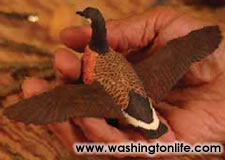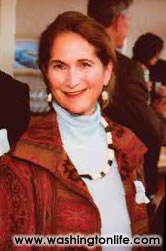Importing AlaskaFalling through the ice
|
||||||||||||
 |
In March 2002, Barbara Overstreet and I were fortunate enough to be invited to fly one thousand miles from Anchorage to Nome along the Iditarod Trail. While there we saw the impact of climate change and how Native residents are dependent on the land and sea for their livelihood. We heard firsthand stories of how fishermen are literally falling through the melting ice and listened to their impassioned pleas to protect their environment and way of life.
From the Athabascan Indians of the vast Interior and Yukon river delta, to the Inupiat (Eskimo) villagers along the shores of Bering Sea, we were also welcomed and overwhelmed by the talent and works of art we encountered for sale—seemingly without a way to reach an appreciative market. That was the seed that ultimately spawned our non-profit foundation.
The Alaska Native Arts Foundation was founded in 2002 by a dedicated group of Alaskan Native leaders, prominent Washingtonians and mothers from the Potomac School. What drew us together was a shared love for the great people and talent that Native artists represent.
On behalf of the Alaska Native Arts Foundation and with the collaboration of the Smithsonian’s Arctic Studies Center, we are delighted to welcome visitors to this first-ever “Alaska Native Arts and Culture Festival,” from November 4th through November 7th. This event encompasses many aspects of Alaskan Native life that are not usually experienced at the same time: exhibits of historic artifacts, art shows, live music, dance performances, documentary and IMAX films, a panel discussion on Arctic climate change as documented by Siberian Yupik residents, and a presentation on restoring the historic King Island village in the Bering Strait.
Thanks to Willie Hensley, founder and president emeritus of the Alaska Federation of Natives, Catherine Stevens, Veronica Slajer and Jack Ferguson— all Alaska supporters now living in Washington— we created an organization that operates simultaneously in the two vastly different worlds of Alaska and the East Coast. With our staff in Anchorage, we travel regularly to remote villages to meet artists and post their works for sale on our website, alskanativearts.org.
Most importantly, we strive to make “Lower 48” Americans aware of their Native co-citizens whose ancestors date back tens of thousands of years to the Bering Land Bridge; who still possess vast stores of knowledge from times past, that should be treasured by our modern society; who live and walk in places of unmatched beauty and majesty; and who—through Congressionally mandated ownership of a total of 44 million acres of their ancestral hunting and fishing grounds—are the custodians of a vast, rich and magnificent stretch of wilderness and tundra.
These are the people who feel the brunt of the melting Arctic ice cap. Residents of St. Lawrence Island in the Bering Sea (closer to Siberia than to Nome, Alaska), will be at the Smithsonian to share first-hand observations of how thinner and smaller ice floes causes a growing scarcity of marine mammals whose meat is relied upon to feed entire villages. We hope to share these and other exciting discoveries of Alaskan Native experiences with you will be the beginning of your own excitement about the rich cultural experiences we so want to share with you.
 |
 |
